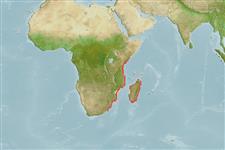>
Carangaria/misc (Various families in series Carangaria) >
Polynemidae (Threadfins)
Etymology: Polydactylus: Greek, poly = a lot of + greek, daktylos = finger (Ref. 45335); malagasyensis: Named for old name of Madagascar, Malagasy, its type locality (Ref. 40958).
Environment: milieu / climate zone / depth range / distribution range
Écologie
marin; saumâtre démersal; profondeur 5 - 62 m (Ref. 40958). Tropical; 1°N - 35°S, 25°E - 51°E (Ref. 57343)
Western Indian Ocean: Kenya, Mozambique, South Africa, and Madagascar. Likely to occur in Somalia and Tanzania.
Taille / Poids / Âge
Maturity: Lm ? range ? - ? cm
Max length : 14.9 cm SL mâle / non sexé; (Ref. 40958)
Épines dorsales (Total) : 9; Rayons mous dorsaux (Total) : 12 - 13; Épines anales: 3; Rayons mous anaux: 12; Vertèbres: 24. With 6 pectoral filaments; uppermost not reaching to (or extending slightly beyond) posterior tip of pectoral fin. Pectoral fin, rays long, 21-26% of SL; fin base long, 10-12% of SL; all rays branched except uppermost 1 or 2. Second dorsal spine long, 7-9% of SL. Well-developed swim bladder. A large black spot anteriorly on lateral line (Ref. 40958).
Found in estuaries as well as offshore (Ref. 57343).
Life cycle and mating behavior
Maturité | Reproduction | Frai | Œufs | Fécondité | Larves
Motomura, H., 2004. Threadfins of the world (Family Polynemidae). An annotated and illustrated catalogue of polynemid species known to date. FAO Spec. Cat. Fish. Purp. Rome: FAO. 3:117 p. (Ref. 57343)
Statut dans la liste rouge de l'IUCN (Ref. 130435: Version 2024-1)
Menace pour l'homme
Harmless
Utilisations par l'homme
Pêcheries: sans intérêt
Outils
Articles particuliers
Télécharger en XML
Sources Internet
Estimates based on models
Preferred temperature (Ref.
123201): 24 - 27.5, mean 26.4 °C (based on 50 cells).
Phylogenetic diversity index (Ref.
82804): PD
50 = 0.5000 [Uniqueness, from 0.5 = low to 2.0 = high].
Bayesian length-weight: a=0.01738 (0.00764 - 0.03951), b=3.05 (2.85 - 3.25), in cm total length, based on LWR estimates for this (Sub)family-body shape (Ref.
93245).
Niveau trophique (Ref.
69278): 3.5 ±0.5 se; based on size and trophs of closest relatives
Résilience (Ref.
120179): Haut, temps minimum de doublement de population inférieur à 15 mois (Preliminary K or Fecundity.).
Fishing Vulnerability (Ref.
59153): Low vulnerability (10 of 100).
